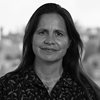Subtotal: $
Checkout
When the islamic state invaded the ancient Christian city of Qaraqosh in Iraq on August 6, 2014, the nearly fifty thousand inhabitants all fled: mothers and children, priests and nuns, engineers and farmers and musicians. Among them was Sami Lalu Jahola, an elderly artist who had spent his life painting the sacred art hanging in many of the city’s churches. Though he and his family escaped, nearly all his art was left behind and systematically destroyed.
By the time I met him, three years later, he was living as a refugee in Jordan, and all that remained of his annihilated paintings were their photographs. Yet as I came to know his collection, taking in the images of Mary and Jesus, the particular saints venerated in his birthplace, and the women of Qaraqosh adorned in their traditional costumes, I began to understand that a photograph of a destroyed painting can become its own work of art: a memory-scape that outlasts the world it depicted, a beauty that survives its own destruction. The faces within these photos become all the more powerful for carrying the burden of what has happened to them. With both his paintings and photographs I have come to think of Sami Lalu as an accidental artist of memory – a recorder of that which has vanished, but also remains. As the poet W. S. Merwin wrote: “What you remember is saved.”
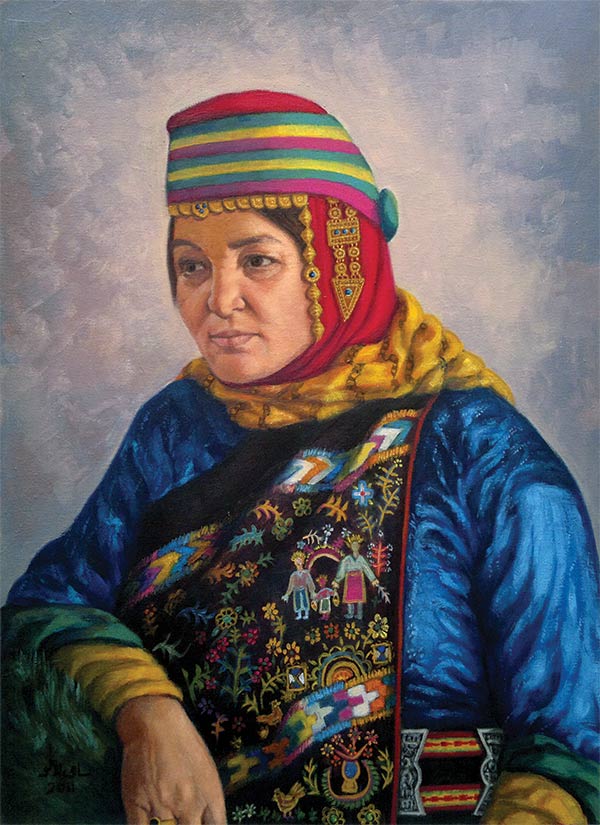
Sami Lalu Jahola, Bride of Qaraqosh, detail
All images used by permission from the artist
I learned of Lalu’s work from other Qaraqosh refugees in Amman, Jordan, who told me that hidden in their neighborhood lived one of their city’s best-known painters. He composed the devotional works that they had grown up with, including those of the famed monastery of Mar Behnam and Sarah. When ISIS invaded, his children scattered to several countries, and he and his wife fled here.
The first time I saw Lalu, he was walking towards the Total gas station in the Hashem al-Shomali neighborhood where we had fixed an appointment, approaching slowly and deliberately. In his late seventies, with white hair, he was carefully dressed in a black suit despite the blistering heat. He greeted me warmly, and then led me back along the street, through a gate and small garden, up a few stairs, and finally into the tiniest of apartments – sparsely decorated and clearly not his permanent home. His wife, Sabiha, greeted him in their variant of Syriac, the dialect of Aramaic that they spoke together. I noticed a few new paintings on the walls, fresh creations in exile. So it was that I began to visit Sami Lalu, so that he might recount to me his decades as a painter in the Nineveh Plains of Iraq.
“Who is that woman in the painting?” I asked Lalu. The photograph of the portrait Bride of Qaraqosh caught my eye immediately as both painting and historical document. The radiant bride stares serenely ahead, adorned in the complete traditional costume of the village of Qaraqosh: a multicolored headpiece embellished with gold jewelry, a blue jacket, a yellow undergarment called a shokta, a yellow and black habria scarf worn for festive occasions. For the top layer, the bride wears the intricately detailed shal, an outer wraparound fabric embroidered with flowers, families holding hands, birds, and colorful lines. In the Nineveh Plains, every village of Christians possesses its own unique traditional costume, donned particularly by older women on weddings and feast days. The shal marked a woman as being from Qaraqosh as clearly as a name tag.
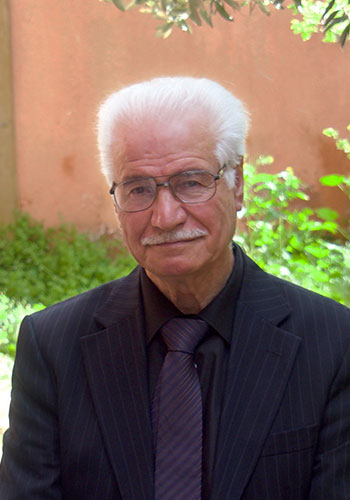
Sami Lalu Jahola
“It’s my wife!” Lalu exclaimed, and he held the photograph of the painting up against Sabiha’s aging face so that I might recognize her.
“I was skinnier back then,” she added, laughing. She told me that it was she who had taken the initiative in their courtship. “I saw him,” she said, “and I grabbed him for myself.” I had to remind myself that the language she spoke with Lalu as she served us tea was in danger of disappearing. Every now and then, his phone would ring with calls from their children, who had resettled in France and Australia, with one remaining in Iraq, and he would put the phone on speaker so that their voices echoed in the room, both gone and still there.
I had expected to be taken by Lalu’s religious paintings, but it was his paintings of daily life that drew me in – uncomfortable reminders that such lives can be forever interrupted. The traditional costume reappears throughout Lalu’s work. He showed me the photograph of a painting of the village women of Qaraqosh, wearing their traditional dresses and walking beneath a monumental stone arch, the same yellow scarf wrapped around each of their shoulders. The shal, this time unadorned, appears again in a third painting of villagers harvesting wheat. In yet another painting, his daughter poses wearing the traditional Assyrian costume of a different Christian village: a headpiece covered with feathers. It was as though Lalu knew, even before the war, that it would be important to capture the suchness of his world, costumes and details that would disappear as Christians leave.
Lalu traces his love of suchness back to his childhood. Born in 1942 in Qaraqosh, he wanted to be an artist from the time he was a boy. “I loved to draw at home,” he told me. “I saw how life was beautiful. Everything that I saw, I wanted to replicate.” One of the bishops showed him a book with paintings by Michelangelo, Raphael, and da Vinci.
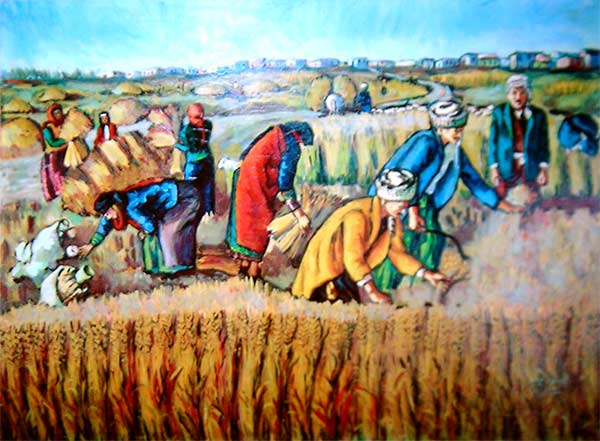
A photograph of Lalu’s painting Al-Hossat in Qaraqosh
“Might that be possible for me?” the young Lalu asked. His father was a weaver. Many others were farmers, and the village was known for its wheat and barley. It was hard to imagine becoming an artist.
Yet his family encouraged him, and eventually he traveled to Baghdad, where he enrolled at the Institute of Fine Arts to study painting, sculpture, and ceramics. When he returned to Qaraqosh, he became the village’s painter and art teacher: Ustez Sami, or Teacher Sami, as a generation of students would call him.
In many ways, Lalu’s task was a practical one. As the largest Christian village in Iraq, Qaraqosh contained seven Catholic churches, many of them dedicated to beloved saints largely unknown outside of the region but venerated by the villagers. These churches needed art. Priests commissioned posters for events and devotional paintings: Lalu’s was the simple painting of the saint, of the holy family, of Jesus being baptized, in front of which a prayer might be murmured or a candle lit. Whenever a new bishop or patriarch was installed, Lalu was tasked with composing the official portrait. When he wasn’t teaching or composing religious art, he painted the members of his family.
Lalu’s most visible works were those displayed at the monastery of Mar Behnam and Sarah in a village outside Qaraqosh, where Christians, Muslims, and Yazidis traveled from the surrounding areas on pilgrimage. Sarah and Behnam, two fourth-century martyrs, had been converted to Christianity by Saint Mattai (Matthew) after Sarah was healed of her leprosy. Their father, King Sinharib the Assyrian, ordered their deaths on learning that his children had become Christians, but later repented and built the monastery near their tomb. The saints were so beloved in the city of Qaraqosh that many children bore their names; a second church within the city proper was also dedicated to them.
For years, Sami Lalu’s brother, Monsignor Francis Jahola, was the priest in charge of the monastery. He had encouraged Lalu since childhood, and now he invited him to add several works to the site. On the outside walls, Lalu worked on two white gypsum reliefs – one of Matthew baptizing Sarah, the other of Behnam astride his horse – based on a more ancient engraving within the compound. Inside the church, he completed a painting of the Last Supper, inspired by Leonardo da Vinci’s but adapted to reflect the rural Iraqi context. He lived at the monastery for two years, working on the painting. To paint from life, every day he set a table for Jesus and the disciples, placing clay goblets and towels on the olive wood, setting out flatbread baked by the monastery kitchen, filling in the background with walls of Iraqi stone.
“I spent two years working on it,” he told me. “Now it’s gone.”
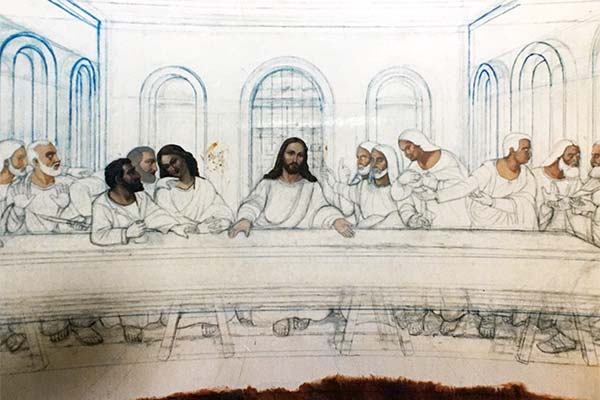
A photograph of Lalu’s sketch of the Last Supper
So, too, is his painting of the baptism of Jesus, as well as the icon-like painting of Mary and child that once hung in a church in Mosul. Yet I have been drawn back time and time again to the photographs of these lost paintings. Perhaps it is because, bound up as they are in everyday scenes and daily piety, these paintings are reminiscent of a deeper grief, that loss of what Karl Rahner, a Jesuit theologian, calls the “theology of everyday things.” It is not the greater losses, but the seemingly smaller ones that seem to haunt those in exile: the lost blessing over a doorway, the dress no longer worn to a wedding, the candle not lit, the particular cup of coffee gone, the local pilgrimage lost. His photographs show that even the most overwhelming grief is expressed most vividly in the particular.
Today, thousands of the Christians of Qaraqosh have resettled around the world, trying to start over in new lands. Others remain refugees in countries like Jordan, hoping for visas. Thousands have also returned to rebuild their city. The churches of Qaraqosh and its environs, too, are being restored, including the monastery. Yet we cannot escape the fact that Christianity in Iraq is on the verge of disappearing.
The last time I went to visit Lalu, his suitcases were packed, and a few weeks later he and his wife left for Melbourne, Australia, where they finally reunited with three of their children. During his final months in Jordan, Lalu had composed one final work: a large painting of Mar Zeina, another saint beloved in Qaraqosh. During our last meeting, he also showed me this painting in the form of a photograph, but not because it had been destroyed by war. Instead, Lalu had asked someone to carry the painting back to Qaraqosh, with the hope that it might be hung in the church of Mar Zeina near his old home, so that a candle might still be lit in front of it, and he might be remembered.
Already a subscriber? Sign in
Try 3 months of unlimited access. Start your FREE TRIAL today. Cancel anytime.


















